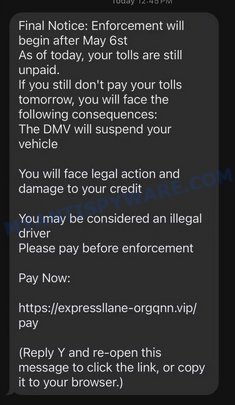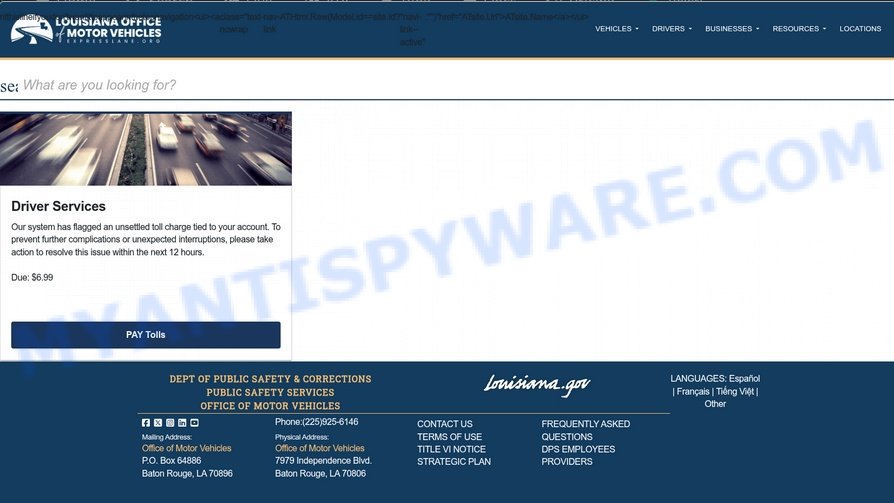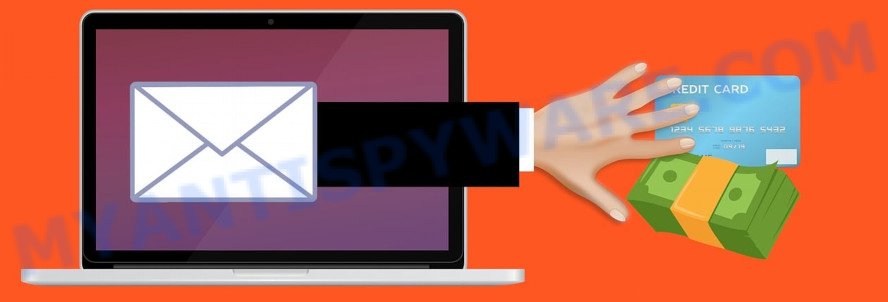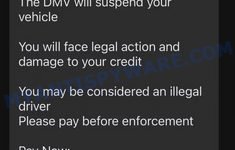Have you come across a text message warning that your tolls are unpaid and that enforcement will start soon? The message states that if you do not pay by a certain date, the DMV will suspend your vehicle, you may face legal action, and your credit could be damaged. It even says you might be considered an illegal driver.
Question: Is this text message, legal notice for unpaid tolls from the DMV or similar government agency?
Investigation Findings: Authorities do not send toll enforcement notices through text messages or direct you to pay tolls via a provided link. Instead, real toll agencies only use their proper websites and official communications. This type of scam, often called “smishing”, tricks people by pretending to be a government toll service to steal personal and financial information.
Answer: Unpaid Toll Text is a fraudulent scam designed to steal your money and information. 💡 To protect yourself from scams like this, do not click on suspicious links or reply to unexpected messages. Always verify any alerts about tolls or fines by checking directly with the official toll agency or government office through their verified websites or phone numbers. Additionally, keep a close eye on your bank and credit card statements for any unusual activity.
🚨 Is the Unpaid Toll Text Scam a Scam?
The Unpaid Toll Text Scam uses manipulative tactics to lure people into paying fictitious toll fines. Scammers impersonate legitimate authorities—often mimicking agencies like the Louisiana Office of Motor Vehicles—to trick unsuspecting individuals into divulging personal and financial information through phishing websites. These tactics prey on drivers’ fears of penalties and legal consequences, offering a false sense of urgency with dire warnings about license suspension, legal action, or even being labeled an “illegal driver”.
A typical “Unpaid Toll” scam text message may look like this:
Final Notice: Enforcement will
begin after May 6st
As of today, your tolls are still unpaid. If you still don’t pay your tolls tomorrow, you will face the following consequences: The DMV will suspend your vehicle
You will face legal action and damage to your credit
You may be considered an illegal driver Please pay before enforcement
Pay Now:
https://expressllane-orgqnn[.]vip/pay
(Reply Y and re-open this message to click the link, or copy it to your browser.)
Key Red Flags:
- 🌐 Urgent, Threatening Language: The scam text warns that enforcement will begin soon and that failure to pay will result in severe consequences. This aggressive urgency is designed to bypass rational thinking and prompt hasty action.
- 📲 Unsolicited SMS with Payment Links: Recipients receive unexpected text messages asking them to click on a “Pay Now” link. Legitimate toll agencies do not send payment requests or notices through unverified SMS channels.
- 🔗 Phishing Website Imitation: Clicking the link redirects users to a phishing page that closely mimics official government sites. Look for mismatched URLs (like expresslane.org) and poor web design, which are common indicators of a scam.
- 💸 Small, Artificial Charges: The page indicates an odd amount (e.g., $6.99) as the toll due, a strategy aimed at tempting quick, less scrutinized transactions rather than handling large sums which might alert the victim.
- ⏱ High-Pressure Tactics: The message creates a false deadline (e.g., “within the next 12 hours”) to rush users into paying before they have time to verify the authenticity of the notice.
- 👥 Disguised Sender Identity: Although the alert claims to come from well-known toll agencies, legitimate services like TxTag, Peach Pass, or FasTrak have confirmed they do not address unpaid tolls or similar violations via text messages.
In summary, the Unpaid Toll Text is a sophisticated phishing scheme that exploits urgent language, fake websites, and deceptive payment prompts to steal personal data. Always verify any unexpected toll notices by contacting the official agency directly, and avoid clicking on unverified links received via text messages.
🕵️♂️ How the Unpaid Toll Text Scam Operates
Scammers behind this toll text scam kick things off by sending alarming text messages that appear as urgent final notices from legitimate-sounding authorities like your state’s motor vehicle office. These messages warn that unpaid tolls will lead to severe consequences—such as vehicle suspension, legal action, or even damage to your credit—if you don’t settle a supposedly overdue bill immediately.

When recipients tap on the embedded link, they’re redirected to a phishing page that closely mimics an official government portal—replete with familiar logos, official-sounding headings like “Driver Services”, and urgent instructions to act within a limited time. The website even displays a small pending fee (for example, $6.99) along with a prominent “PAY Tolls” button, creating the illusion of an authentic enforcement process.

This scam uses urgency phrases such as “Final Notice” and strict deadlines to pressure victims into hasty decisions. The scammers lean on a design strategy that disguises ordinary text as images, making it extremely difficult for anyone to verify the information with a quick online search.
To further simulate legitimacy, some pages hint at false certifications or claim to be managed by known authorities—even though true toll agencies like TxTag, Peach Pass, or FasTrak would never initiate contact via text message. The use of such deceptive tactics combined with fake assurance of “risk-free” resolution conditions builds a false sense of security, tricking people into providing financial details or making immediate payments.
After a user clicks through and completes the transaction, many end up with further unauthorized charges or encounter unresponsive customer service. In essence, the scam capitalizes on mimicking recognizable agency designs, employing urgent warnings, and fabricating official-sounding messages to dupe individuals into paying tolls that don’t actually exist.
Ultimately, the unpaid toll text scam relies on unsolicited, text-based alerts, fraudulent websites, misleading official imagery, and manufactured urgency. The result is that people are pressured into spending money to settle a non-existent debt, only to find themselves financially compromised and left with little recourse.
📌 How to Report Unpaid Toll Scam Texts
If you get a text message saying you owe toll fees, it’s a scam. Reporting it can help you stay safe and protect others. Here’s the simple way to report these scam texts:
🔍 Spot the Scam Text
Find the text message that seems like a scam.
👉 Use Your Phone to Report
Your phone lets you report a text as spam or scam. Press and hold the scam message to do this.
🚩 Pick the Report Option
Select the right option to report the message. This could be “Report Spam” or something similar.
📱 Tell Your Mobile Company
Send the scam text to 7726. This spells “SPAM”, and it lets your mobile company know about the scam.
🔗 Tell the Authorities
Some places let you report scam texts to the government or groups that protect consumers. Look online to find out where you can report in your area.
🛡️ What to Do Next
If you clicked on the link in the scam text, watch your accounts for any strange activity. Think about changing your passwords. You might also want to tell your bank or credit card company about the scam.
✔️ Finish Reporting
Make sure you follow all the steps your phone, mobile company, or local government asks you to complete the report.
🔍 How to Spot a Scam Text Message
Scam messages often share common characteristics. By learning these signs, you can detect and avoid text scams:

💡 Here Are Some Ways to Recognize a Scam Text
- 📞 Unknown or Suspicious Numbers: Scam texts often come from unknown or very generic numbers, not official customer service numbers.
- 🔠 Misspelled Brand Names: Look carefully for any misspellings in the brand or company names, as scammers often try to mimic real companies.
- 👋 Generic Greetings: Messages starting with vague greetings like “Dear Customer” may not be from trusted companies.
- 🔗 Suspicious Links: Do not click on any links in suspicious messages. Instead, visit the company’s official website directly.
- ⏰ Sense of Urgency: Messages that demand immediate action or else a penalty will apply are often scams.
- 📝 Spelling and Grammar Errors: Scam texts may contain spelling mistakes or grammatical errors. Legitimate companies usually ensure proper language use.
- 🔒 Requests for Sensitive Information: Trustworthy organizations do not ask for passwords, credit card numbers, or Social Security numbers through text.
Threat Summary
| Name | Unpaid Toll Text Scam |
| Type | Phishing |
| Scam Text Content | Final Notice: Enforcement will begin after May 6st As of today, your tolls are still unpaid. If you still don’t pay your tolls tomorrow, you will face the following consequences: The DMV will suspend your vehicle You will face legal action and damage to your credit You may be considered an illegal driver Please pay before enforcement Pay Now: https://expressllane-orgqnn[.]vip/pay (Reply Y and re-open this message to click the link, or copy it to your browser.) |
| Fake Fee | Extra fees (implied) |
| Targeted Information | Full name, address, phone number, credit card details (number, CVV, expiration date) |
| Harm | Loss of money, identity theft risk |
| How It Spreads | Mass text messaging to random or targeted phone numbers |
| Scammer’s Methods | Creating urgency, pretending to be a legitimate toll payment service |
| Variations | Different amounts claimed, various phishing website URLs |
| Protection Tips | Don’t click on links in unsolicited texts; confirm any toll charges directly through official websites; use strong passwords; enable two-factor authentication for online accounts; educate yourself on phishing signs |
| What To Do If You Receive A Scam Text | Don’t use the link in the text; verify any claims through the official site; report the scam to your mobile carrier; monitor your financial statements regularly |
| Reporting Info | Report the text to your mobile carrier by forwarding it to 7726; inform local or national consumer protection agencies; share information about the scam to warn others |
| Whois | Domain Name: expressllane-orgqnn.vip Registrant Information Registrant Name: REDACTED FOR PRIVACY Registrant Organization: none Registrant Street: REDACTED FOR PRIVACY Registrant City: REDACTED FOR PRIVACY Registrant Phone: REDACTED FOR PRIVACY Registrant Country: US Registration Dates Creation Date: 2025-05-04 Registry Expiry Date: 2026-05-04 |
✅ Conclusion
The Unpaid Toll Text Scam is a deceptive operation that relies on fabricated threats, forged enforcement language, and fraudulent claims to trick you into paying nonexistent toll charges. The scammers behind this scheme use urgent messages, mimicking trusted authorities like the Louisiana Office of Motor Vehicles, to instill panic and force hasty actions. Instead of resolving any real issue, victims are coerced into clicking on malicious links that lead to phishing pages designed to steal personal and financial information.
This scam message falsely asserts that enforcement actions, such as DMV vehicle suspensions, legal action, and credit damage, will commence if a small toll fee isn’t paid immediately. It employs scare tactics and misleading urgency, using a fabricated “Driver Services” page that pretends to represent official toll agencies. In reality, legitimate toll providers like TxTag, Peach Pass, and FasTrak have confirmed they never approach customers via unsolicited text messages or use suspicious URLs for toll payments.
Bottom Line: Do not respond to unexpected toll invoices or enforcement threats received via text message. Always verify any toll-related communication directly through the official channels of your local toll agency. Staying informed and cautious can help you avoid falling victim to these elaborate scams.



















